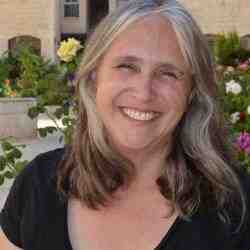Introduction
Despite the image of wealth and renowned social protections in Norway, the voices of young people are not well heard or considered. State-run institutions are staffed by shift workers and young people may often feel they are treated like objects. Prisons mix youth and adult inmates. Many young people in Norway feel they have little voice in their own lives. Marit Sanner is asking kids and young people to find system-changing new ideas and then facilitating their involvement in the policymaking that affects them.
The New Idea
Marit understands that the people who know the most about problematic systems are those that are victimized by the rigid walls of the very system, and the system-changing solutions come from the people within them. Marit has crafted a methodology to get young people to identify these system-changing ideas, build youth consensus on what they are, and open direct communication between service users and implementing agencies to create real change. Marit is taking a chance to create a new system that allows effective engagement between civil society, especially youth, and the state. By getting influential adults to listen to children, she is placing young people as the experts on the policies that concern them, and gathering and inserting their voice, experience, and advice, into policy that guides the system.
With The ChangeFactory (Forandsringfabrikken), Marit gathers insight from youth under state care—from foster children and the chronically ill to those in the juvenile justice system or on welfare—and packages it. She has designed a methodology that approaches kids as professionals, using participatory styles of visuals, projects, and engaging tools to allow kids to voice their opinions. From their perspectives, they choose the “change keys”—the most efficient and common critiques and ideas, and they present them in small magazines to policymakers in dialogues as a collective answer. Following the methodology, compiling, and presenting, Marit creates a corps of “lobbyists” to help push for the shifts they suggest; with success. She is working broadly in Norway and getting a lot of interest internationally. The Ministry of Children and Youth in Norway has asked children to design changes on several levels as a result of Marit’s work, and the Justice Minister has worked with participating kids to design alternatives to jail. Marit’s goal is to teach nations a proven way to genuinely listen to children in a respectful manner.
The Problem
Young people are often patronized. In circumstances where young people are at the whim of the state—whether as residents in institutions or juvenile delinquent centers, hospital patients, under state stewardship with welfare, or as students—there is little to no opportunity for young people’s voice to be heard on/in the important matters. Programs working with young people are almost entirely adult-led, and traditional participatory methodologies have been tried over and over, but have little focus on actually getting adults to listen, and lack follow-up. Common in the youth arena, activists demand change and their confrontational approach provides few solutions and makes institutions recoil.
Norway, among all countries, has an extremely strong arm of the state, and as such can have a paternalistic attitude to citizens and “service users.” Norway also has a strong national identity tied to the idea of being a “perfect society,” so addressing to reform traditional approaches to bring systemic change can be difficult. Young people, or any recipients of care, are insightful about their needs and the changes that would best suit them, yet their voices are not incorporated and listened to. A recent report from UNDP sent a clear message that Norway lags behind on the UN Convention on the Rights of the Child. Marit’s innovative approach could help create opportunities for young people to have an outlet to articulate their needs in a positive way, monitor progress, and participate in an ongoing manner to yield significant impact in society.
The Strategy
With a lengthy background working with young people in the care of the state, Marit became obsessed by the alienation and prejudice they suffered; underneath the veneer of a “perfect society.” She began asking young people to describe the realities of youth in Norway, and saw patterns among the answers from around the country. Young people felt disenfranchised from their own lives, and most emphatically so among those who were in the care of the state in some capacity, from foster children to residents of state-run institutions to those in juvenile delinquent centers—all too frequently victims of institutional prejudice. Marit was struck by a contradiction: Simple practical suggestions young people offered to improve their own care coupled with a complete lack of user voice and empowerment. Her revelation: “I knew that I was with some very smart people.” Marit realized there was a great wealth of expertise untapped in young people, and insights that could dramatically change their standard of care and independence, as well as an opportunity to respect and empower them at their most powerless. She is driving a strategy that includes youth in making system-changing decisions, which affirms problem-solving processes.
Marit began to adapt participatory methodologies to make it engaging and attractive for young people to tell the truth about their situation. With Marit’s methods, they learned that people would listen to them without punishing them for their honesty. Working with a national cross-section of young people in state care (e.g. children in a juvenile delinquent center, hospital, or foster care) Marit employs visual tools such as film, art projects, and photography and assigned young people tasks such as “take pictures of the best and worst parts about where you live.” From this methodology, she and her team work with young people from the ages of eight to twenty, to build consensus on central themes and recurring points about how systems can help them best. These main points of policy shift are honed and compiled in small easily digestible magazine formats, which are then presented by the children through an apolitical, facilitated dialogue with ministers and high-level officials. Children are placed as the “professionals,” the experts about their own lives and needs. Marit is quick to emphasize that they are “not creating manuals—these kids have told us enough about manuals,” but a presentation of the most efficient and effective “collective answers” explained through user experience. She is careful not to select “the best” or most well-behaved and articulate children to present this part of the process, and hosts the meetings without media presence to allow for open dialogue.
Marit has found the steepest learning curve to be among adults, accustomed to a surface relationship with young people, or a joking type approach that precludes actual listening. It is often the greatest challenge in her work to train adults—to listen to children in a genuine way. In tandem, Marit trains children in how to work with adults.
The process Marit has designed has revealed some simple yet shocking changes suggested by the young people. For example, her first project focused on young people in institutions, who commented that staff schedules should be designed to make young lives as normal as possible, rather than for staff convenience. The high turnover and switch left the kids feeling disjointed and separate. Young people in hospitals noted that “doctors say medical things and nurses say human things,” adding that doctors rarely explain what they’re doing and why. Young people within the justice system explained to the Minister of Justice that it creates more problems to mix all crimes together within delinquent centers. One important policy shift thus far has been in regard to the practice of holding down out of control children, used by professionals within institutions. It was considered best practice to hold down or otherwise restrain children who were acting out as a calming tool. Marit’s work revealed that this practice terrifies and traumatizes young people. Thus, the practice has been reduced on a nationwide basis in Norway.
Following the dialogue process with leaders, Marit engages kids in a lobbying role after their facilitated presentations, following up to secure passage of their suggested changes and advocating for their opinions to be heard in the halls of power. The continued monitoring and presence from the children has a powerful effect on their own self-belief, and has greatly spurred the adoption of their proposed changes.
Marit is focusing on genuine policy shift in other areas as well. She is working with various areas of government to institute her participatory practices into government systems that work with children, and has her eye on the fields of psychiatry and schools as a next step. As a result of Marit’s work, the Norwegian Minister of Children has asked young people to design changes to programs, and the Minister of Justice is working with young people to create alternatives to jail. Marit’s work is poised for significant expansion—she has trained the Swedish Ombudsman and her staffs in her methods, and they have executed her work across Sweden over the past year.
The Person
As an oldest child, Marit helped raise many of her younger siblings. Her mother, a politician, taught her to never be afraid of authority. As a young person, Marit had a revelation that “adults are not as smart as they intend to be,” pointing to that moment as one where she felt her limits fall away. Always drawn to young people, she started children’s clubs and distinguished herself as an athlete and a highly acclaimed coach, only a few years older than her players. In her late teens, Marit was one of ten young people chosen from across Norway for a prestigious software development program, but felt continually called to children. Marit’s life was rocked by tragedy when her treasured younger brother died in a freak accident. This was very important in reminding her that life is short—too short not to work hard for change.
Trained as an anthropologist, Marit was fascinated by “letting others describe their own reality.” She understood the failures of participatory learning, and began the apprenticeship that would lead her to found Forandsringfabrikken. Inspired by Nelson Mandela and Mahatma Gandhi, she worked in institutions with young people, creating a string of kids clubs that allowed young people to have a voice, and a strong apprenticeship period. Working with Save the Children, Marit began implementing some of her ideas that would eventually become Forandsringfabrikken. In working on their efforts around the UN Convention on the Rights of the Child, she realized that little of the work addressed Article 12, the clause that concerned listening to children. Adopting a confrontational attitude, which she later left behind, Marit challenged Save the Children on the strength of their values-thinking and genuine focus.
Hired by the Norwegian Ombudsman to do a UN report on children, Marit crafted a strategy that reported entirely from the child perspective, drawing insights from young people and a year later followed up on the progress of proposed changes. Marit brought together officials and children, without media presence. She was shocked to find departments closed to her, the report censored, and the plan crushed—the officials who hired her seemed “scared of children.” Realizing the power of her idea, the influential tool of a non-confrontational, inspiring approach, Marit left her job and started The ChangeFactory (www.changefactory.no).




